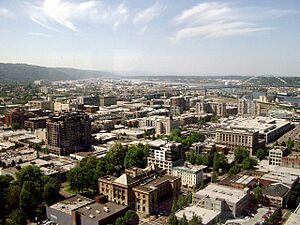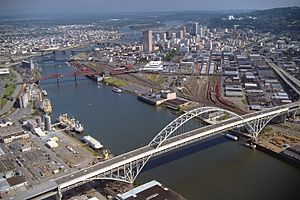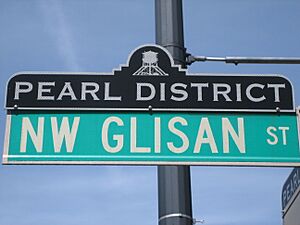Pearl District, Portland, Oregon facts for kids
Quick facts for kids
Pearl District
|
|
|---|---|
|
Neighborhood
|
|
| Country | United States |
| State | Oregon |
| City | Portland |
| Area | |
| • Total | 0.47 sq mi (1.21 km2) |
| Population
(2010)
|
|
| • Total | 5,997 |
| • Density | 12,840/sq mi (4,956/km2) |
| Housing | |
| • No. of households | 5315 |
| • Occupancy rate | 79% occupied |
| • Owner-occupied | 1493 households (28%) |
| • Renting | 2699 households (51%) |
| • Avg. household size | 1.13 persons |
The Pearl District is a cool neighborhood in Portland, Oregon. It used to have lots of old warehouses and train yards. Now, it's famous for its art galleries, fancy shops, and homes.
Since the 1980s, this area has changed a lot. Artists started moving in, old structures were removed, and the Portland Streetcar was built. Many old industrial buildings are now offices. Warehouses have become cool loft apartments, and new high-rise buildings have been built. For example, the Cosmopolitan on the Park building opened in 2016. It's now the tallest building in the Pearl District. It's also the 8th tallest building in all of Portland.
Contents
Exploring the Pearl District
The Pearl District is located just northwest of downtown Portland. It's bordered by West Burnside Street to the south and the Willamette River to the north. NW Broadway is to the east, and the Interstate 405 freeway is to the west.
This area is home to some famous Portland spots. One is Powell's City of Books, a huge bookstore. The old Weinhard Brewery was here too. It made beer from 1864 until 1999. After it closed, the area was redeveloped into the "Brewery Blocks."
You'll find many art galleries here, like the Elizabeth Leach Gallery and Blue Sky Gallery. They often have special events each month. There are also lots of unique shops, restaurants, and small clubs. Because of all these cool places, the Pearl District was named one of the 15 coolest neighborhoods in the world in 2016.
The main Post Office for Oregon and southwest Washington is also in the Pearl District. It was built in 1964, right next to Union Station. This spot was chosen to help serve towns outside of Portland better.
Parks and Green Spaces
The Pearl District has several great parks where you can relax and play.
- North Park Blocks (created in 1869) are historic green spaces.
- Jamison Square (opened in 2002) has a unique fountain. It fills up like a tidal pool and then drains away.
- Tanner Springs Park (opened in 2005) is a re-created natural area. It has wetlands, a walking trail, and a small creek.
- The Fields Park (opened in 2013) is a neighborhood park and a dog park. It's in the northern part of the Pearl District. It's a great place for art events, community gatherings, and walks.
History of the Pearl District

This area was once full of warehouses, light factories, and a railroad yard.
The name "Pearl District" first appeared in print in March 1987. It was in an article by Terry Hammond in The Rose Arts Magazine. Marty Smith later explained how the name came about in 2014. Hammond said he wrote the article to make the name stick. He worked hard to promote the name in the neighborhood.
Before that, the city called the area "the Triangle." The local business group also used "the Triangle" but didn't like it much. Other names like "Brewery District" were considered. Hammond's article in The Rose Arts Magazine suggested "The Pearl District." It argued this name was best because of all the art and artists in the old warehouses. The article showed photos of the area and featured artists with studios there.
Terry Hammond later shared that the name "the Pearl" came from Thomas Augustine of the Augustine Gallery. Hammond saw the name gain popularity. By October 1989, he reported that the "Pearl District" identity was "firmly established." Investors even started using the name. The first warehouse converted into homes, the Irving Street Lofts, used "Portland’s emerging Pearl District" in its brochure.
The name quickly spread.
- Victoria Frey, who ran the Quartersaw Gallery, loved the name. She organized the first Pearl Arts Festival in September 1987.
- Sunset Magazine used the name in January 1988.
- The Oregonian newspaper started using the name in September 1988.
- Investors began using the name in their marketing materials for new homes in 1989.
In the 1990s, the Lovejoy Viaduct was taken down. This was an elevated road that ran through the area. Its removal opened up many blocks for new buildings. This development really grew in the 2000s. The viaduct was famous for its Lovejoy Columns, which were painted by a railroad worker. Two of these columns were saved. The growth of the area has brought in many restaurants, brewpubs, shops, and art galleries. The movie Drugstore Cowboy (1989) also filmed some scenes in the neighborhood.
Images for kids
-
The Pearl District and surrounding area, as seen from the US Bancorp Tower






